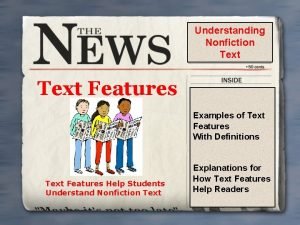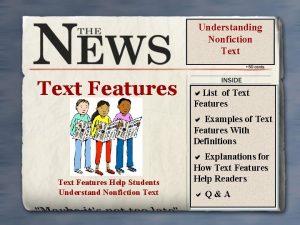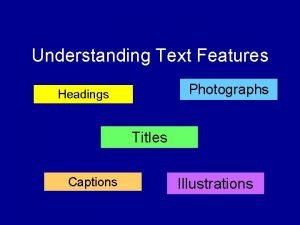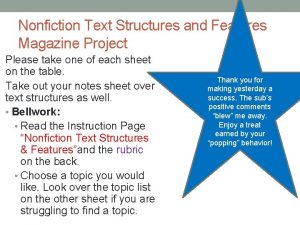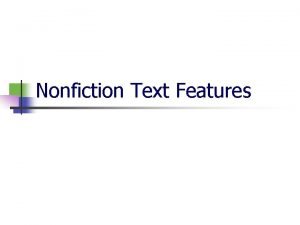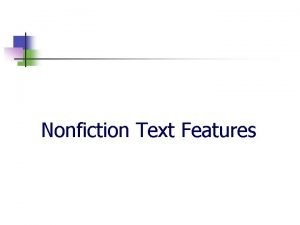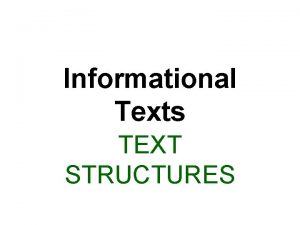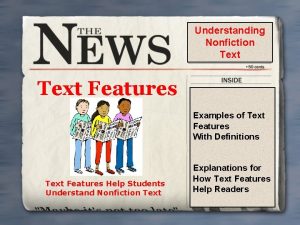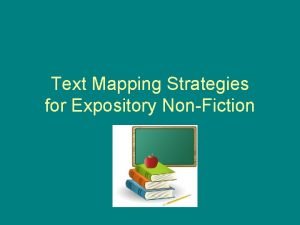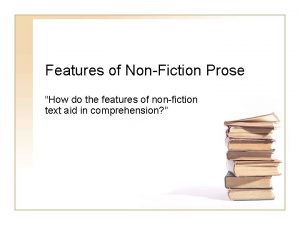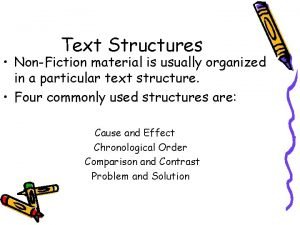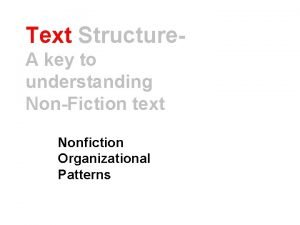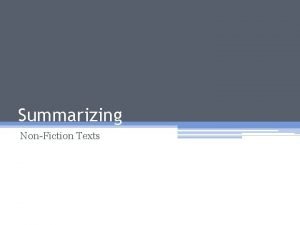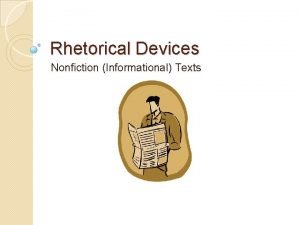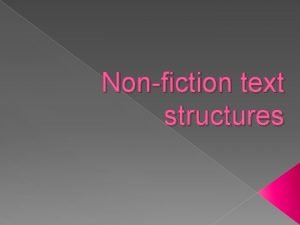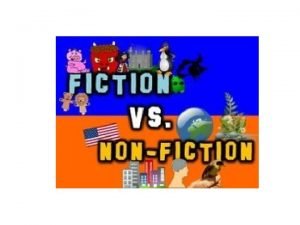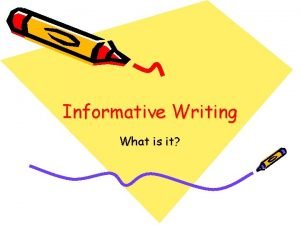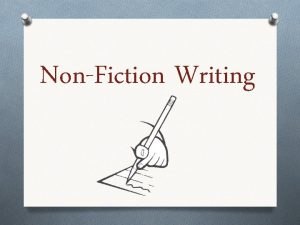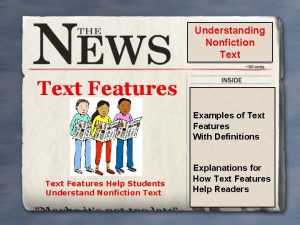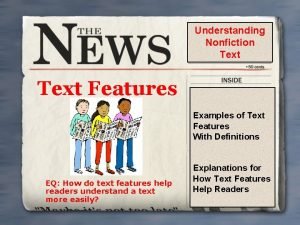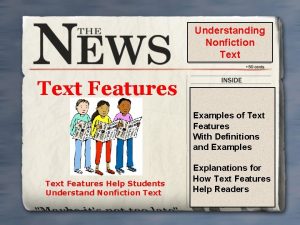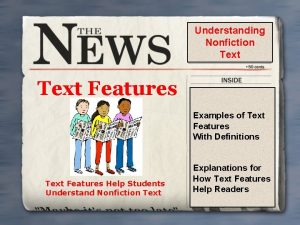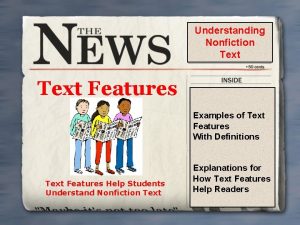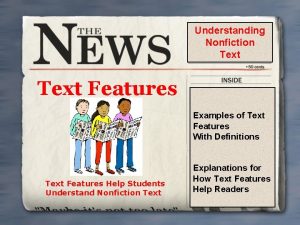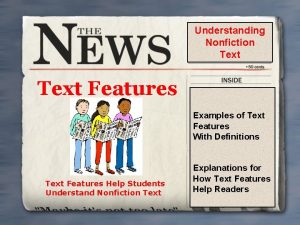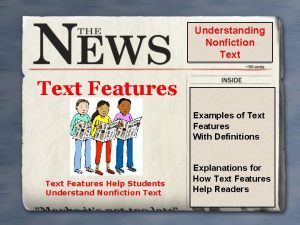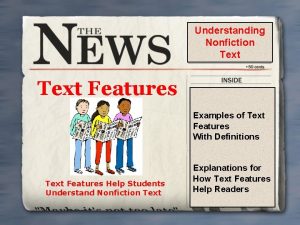Understanding Nonfiction Text Features Examples of Text Features


















- Slides: 18

Understanding Nonfiction Text Features Examples of Text Features With Definitions Text Features Help Students Understand Nonfiction Text Explanations for How Text Features Help Readers

What are text features? • Text features help the reader better understand what they have read. • Text features provide additional information. • Text features help the reader visualize the text.

Titles and Subtitles Title: The Name of the Book Subtitle: Provides additional information about the book’s contents

Where do you find this in a nonfiction book? Table of Contents • Lists the major parts of a book with page Chapter 1: All About Animals numbers. Animal Adaptations ……. . Page 1 • It outlines the main Animal Food………. . Page 2 topics or main points. Animal Habitats. ………. . Page 3 • Readers can use the Animal Homes. . ………. …Page 4 table of contents to Chapter 2: All About Plants help locate Photosynthesis …………. Page 5 information and see Types of Plants …………. Page 6 how everything is Where would a reader find organized. information about where an animal lives? Table of Contents

When should you read the headings? Headings What do the headings of the articles in these newspapers tell you? • Headings tell the reader the main idea of the text. • Headings help the reader by letting them know what they are about to read. • Headings focus the reader on a topic so they can make connections between what they already know and the text.

Can be found _____ the main heading. Subheadings • Helpful Ants Although ants are frustrating when they get in homes, ants do help the • environment. They help control the population of damaging pests such as • termites. Subheadings divide the text into sections. Subheadings tell the main idea of each section. They are printed in large or bold type to make them stand out. Types of Ants Types of ants include fire ants, which • Subheadings help the reader to locate cause a painful sting, and carpenter information in the ants, which damage wood structures text by telling them while nest building. Other types of where to look. ants include honey, pharaoh, house, Argentine, and the thief ant.

How might these photos help the reader understand the text? Photographs Illustrations • Photos and illustrations help the reader picture the information. • They give additional information. • They work with the words and headings to help teach material. • Used to explain difficult sections.

How does this caption help the reader understand the picture? Captions • A caption explains a picture or illustration. Photo by MARCIN SZCZEPANSKI These gold coins were found on the ocean floor! • Captions help the reader understand information that may or may not be in the text.

How do the words in italics help the reader understand the text? Bolded & Italicized Words • The style and color of the The Wetlands of the South text sends the reader signals about how to Why are the South’s wetlands read the content. so important? • Text in italics is used in The Okefenokee (oh kuh fuh picture captions, book titles, foreign language, NOH kee) Swamp is a large p, and to emphasize. . wetland in the South. A wetland is a place where the • Text in bold or color draws the readers ground is soaked with water for attention to important at least part of the year. vocabulary, usually found in the Glossary.

Footnote

Graphs • Graphs give a lot of information in a little space, with a visual—usually used in texts for compare/contrast, or to show growth. • Gives the reader a visual to rely on.

Charts (Tables) • Charts organize large amounts of information in a small space. • Charts help the reader compare information in the text. How would a chart about volcano eruptions help the reader understand volcanoes?

A Glossary is like a mini dictionary. It is always found where? Glossary A Acid rain (AS ihd rayn) rain that carries certain kind of pollution. Adapt (uh DAPT) to change in order to survive in new environments How would the glossary help the reader understand text about animal adaptations? • A list of key terms in alphabetical order. • Each key word is defined-gives meaning. • Sometimes a glossary also tells you how to pronounce a word. • Readers use the glossary to help them better learn and understand the subject.

Annotations • Annotations are just notes on the text—sometimes questions, sometimes extra information.

Where is this located? Index A Abu Simbel, temple of, p 73 Acadia, Canada, 212 -213 Acid rain, 396, c 396 -c 397, 396 -397 Animal Adaptations p 1 Animal Food p 2 Animal Habitats p 3 Animal Homes p 5 Where would a reader find information in the text about acid rain? • Is an alphabetical listing of the key names, terms, events, and topics with page numbers. • Readers use the index to help find pages that contain information they are looking for.

Diagrams • A diagram is a drawing that shows or explains something. • To understand a diagram the reader should read the titles, labels, captions, and numbered parts. • Diagrams help the reader understand steps, how objects are made, or information in How could this diagram help the text. reader understand volcanoes?

Timelines (a type of chart) • Timelines show important events in chronological order or time order. • Timelines help the reader better understand how one event caused or effected another event. How would a timeline help a reader understand why some older people aren’t knowledgeable about computers?

What is the MAIN purpose of the sidebar below—what color is it? Sidebar • A sidebar can include interesting facts or important information the author wants the reader to know. • sidebars help readers understand by creating interest or emphasizing The sidebar above asks the reader a important question. information.
 Text box text feature
Text box text feature List of text features
List of text features Heading text feature
Heading text feature Nonfiction text structures examples
Nonfiction text structures examples What is a caption in a nonfiction book
What is a caption in a nonfiction book Photo caption
Photo caption Text _____ in a nonfiction text is its organization.
Text _____ in a nonfiction text is its organization. Nonfiction text examples
Nonfiction text examples Text mapping
Text mapping Text to text text to self text to world
Text to text text to self text to world Features of nonfiction prose
Features of nonfiction prose What is text structure in nonfiction
What is text structure in nonfiction Types of nonfiction text structure
Types of nonfiction text structure Summarizing nonfiction
Summarizing nonfiction Rhetorical devices in informational text
Rhetorical devices in informational text Nonfiction text structure
Nonfiction text structure How to summarize nonfiction
How to summarize nonfiction What is nonfiction
What is nonfiction Define informative writing
Define informative writing
